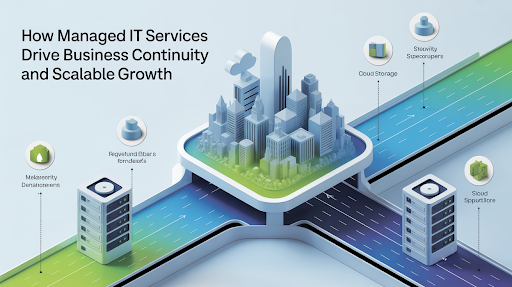Technology problems can bring a business to a halt. Lost data, slow systems, or unplanned downtime frustrate teams and cost companies money. These issues don’t just feel chaotic—they hurt growth and trust with customers. Managed IT services help businesses avoid these pitfalls. By addressing your tech challenges before they arise, you keep operations running efficiently. This blog will explain how managed IT services support both stability and growth for companies like yours.
Stay tuned to discover straightforward ways to tackle major tech challenges!
The Role of Managed IT Services in Business Continuity
Managed IT services ensure businesses operate efficiently during unforeseen challenges. They safeguard essential systems and secure important data from risks.
Minimizing Downtime with Proactive Monitoring
Monitoring with foresight helps detect problems before they escalate into major disruptions. Teams maintain constant vigilance on networks, servers, and devices around the clock. This enables them to address issues promptly and significantly minimize downtime. For example, businesses experiencing recurring system interruptions can reach out to AdRem Systems to implement proactive monitoring and support tailored to their infrastructure.
“Minutes matter when systems fail,” as many IT experts say. Rapid identification and resolution of system issues lead to smoother operations for businesses. With quicker troubleshooting in action, efforts focus on safeguarding data, the next critical priority for continuous growth.
Ensuring Data Security and Disaster Recovery
Hackers and cyber threats aim to exploit sensitive data daily. Managed IT services enhance cybersecurity by applying firewalls, encryption, and malware protection tools. They conduct regular vulnerability assessments to identify weaknesses before bad actors do. Cloud backup solutions safeguard critical files from loss due to breaches or technical failures. Encryption protects information during transmission, keeping it safe from prying eyes.
Natural disasters, hardware failures, or power outages can occur unexpectedly. Disaster recovery plans help businesses recover quickly after disruptions like these. Managed IT teams establish regular backups stored in off-site locations for added safety. Virtual servers minimize downtime by enabling operations to resume even if physical systems fail temporarily.
Driving Scalable Growth Through Managed IT
Managed IT services adjust to your business growth, ensuring systems operate efficiently. They also assist in predicting future needs without making operations overly complex.
Flexible IT Solutions to Support Expansion
An adaptable IT infrastructure adjusts as businesses grow. Cloud computing, for instance, provides flexible resources without requiring massive upfront costs. Companies can modify storage or processing power based on demand. Investing in flexible systems means your business grows smoothly, said an IT consultant at TechNova.
Strategic IT Planning for Future Business Needs
Planning IT systems for growth keeps businesses prepared for change. Adaptable infrastructure aligns with company needs as they grow. Emphasizing cloud computing, automation, and remote support enhances operations while reducing expenses. Technology updates avoid outdated tools hindering future objectives.
IT planning also safeguards resources with risk management strategies like cybersecurity improvements and backup systems. It minimizes downtime risks during transitions or unforeseen events. Thoughtful preparation ensures seamless scaling to meet new demands without interrupting ongoing operations. Adaptable IT solutions provide reliable foundations to support growth efforts effectively.
Key Benefits of Managed IT Services
Managed IT services improve business operations by keeping systems dependable and efficient. They equip businesses with the resources and knowledge required to remain competitive in a rapidly evolving world.
Predictable IT Costs and Budgeting
Fixed monthly fees simplify IT budgeting. Businesses can allocate resources without surprise costs from sudden hardware failures or unexpected repairs. This clarity removes financial uncertainty, allowing owners to focus on growth rather than unplanned expenses.
Cost predictability also aids in long-term planning. Companies know what to invest in upgrades or expansions without compromising operations. Accessing these benefits ties directly into the specialized expertise that managed services provide, discussed next.
Access to Specialized IT Expertise
Predictable IT costs allow businesses to allocate resources efficiently, but expertise brings that strategy to fruition. Managed IT services provide access to trained professionals with extensive knowledge of cybersecurity practices, data protection techniques, and disaster recovery solutions. These professionals stay informed on the latest industry advancements and compliance standards. Their skills help avoid downtime by resolving complex technical issues swiftly.
Teams like Alexant’s IT engineers offer deep experience across industries, ensuring efficient issue resolution and expert guidance for scalable systems. For many small or medium-sized businesses, hiring an in-house team with this level of talent can be costly. Managed services address that needs without overextending budgets.
Enhanced System Performance and Reliability
Managed IT services keep systems running efficiently by addressing issues before they affect operations. Regular maintenance and 24/7 support minimize downtime, helping businesses prevent expensive disruptions. These services ensure high performance while prolonging the life of hardware and software.
Strong dependability fosters confidence in your IT structure. Quick response times for troubleshooting ensure vital tasks remain on schedule. Ongoing updates enhance productivity and protect data from potential risks such as cyberattacks or system malfunctions.
Choosing the Right Managed IT Service Provider
Finding the right provider can feel like searching for a needle in a haystack. Concentrate on those who match your objectives and comprehend your difficulties.
Evaluating Service Offerings and Expertise
Assessing a managed IT service provider takes focus and preparation. Business owners must weigh their needs against what the provider offers.
- Review the range of services. Look for backup, disaster recovery, cybersecurity, and IT infrastructure support. Confirm these align with your business goals.
- Check for certifications and expertise. Providers should hold industry-standard certifications like CompTIA or Microsoft Partner status.
- Ask about response times. Quick remote support reduces downtime, so confirm they have clear Service Level Agreements (SLAs).
- Request case studies or references. Successful projects demonstrate their track record of maintaining business continuity.
- Ensure growth potential options are available. The provider should accommodate expansion opportunities without creating obstacles.
- Verify data protection measures. They must emphasize cybersecurity with strong encryption protocols and compliance policies.
- Evaluate customer support quality. A 24/7 help desk ensures efficiency whenever issues arise.
Measuring success with key performance indicators is the logical next step to assess service impact effectively.
Measuring Success with Key Performance Indicators
Success in managed IT services depends on measurable outcomes. Key performance indicators (KPIs) offer a clear understanding of whether your investment in these services is yielding results. Let’s outline this in a simple table.
| KPI | What It Measures | Why It Matters |
| Uptime Percentage | System availability | Measures reliability and service continuity |
| Incident Response Time | Time taken to address IT issues | Reflects efficiency in troubleshooting |
| Issue Resolution Time | Time to fully resolve IT problems | Highlights service provider effectiveness |
| Data Backup Success Rate | Frequency of successful data backups | Protects against data loss |
| Network Speed | Performance of key networks | Affects productivity and user experience |
| Customer Satisfaction Score | Feedback from end users | Shows service quality from a user standpoint |
| Cost Per Ticket | IT service costs per incident | Assesses budgeting efficiency |
Each KPI centers on outcomes that impact operations. Define clear standards. Monitor results consistently. Review trends over time for informed decision-making.
Conclusion
Managed IT services keep businesses running effectively. They reduce risks, protect data, and enhance reliability. With expert support, companies can handle growth without challenges. Technology becomes a tool for success instead of an obstacle to address. Partnering with the right provider creates stability and paves the way for future opportunities.





























